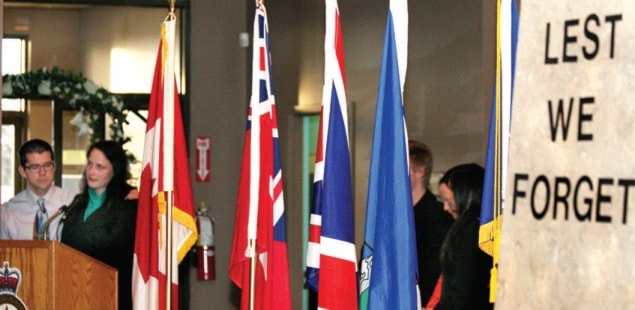On the 96th anniversary of Canada’s coming of age as a nation, Ponoka Legion members and students from the Broncs World Tour to Europe met to share their stories.
Legion president Stan Orlesky was a chaperon on the spring break tour to war cemeteries and put the visit into a military and historical context.
“The Battle of Vimy Ridge was the first instance when all four Canadian divisions participated in battle together,” he said. The size and scope of the planned assault in France required support and resources beyond the young Canada’s normal operational capacity.
“The attack began at 05:30 on April 9, 1917,” Orlesky explained. The offensive had been delayed a day at the request to take advantage of poor weather that would then be blowing in the faces of the German troops.
The first, second and third Canadian divisions achieved their objectives in about an hour but the fourth division encountered some difficulty and was cut down when they left their trenches. By the next day, the regrouped Canadians took Hill 145 but had one objective left — to take a hill known as The Pimple.
Orlesky said the Canadians were in control of the ridge by nightfall April 12 but at a cost of 10,602 casualties: 3,598 dead, 7,004 wounded. They took 4,000 German prisoners of war.
“The Battle of Vimy Ridge has considerable significance for Canada,” he said. “Although the battle is not generally considered Canada’s greatest military achievement…it was the first instance in which all four Canadian divisions, made up of troops drawn from all parts of the country, fought as a cohesive formation.”
Vimy is the final resting place for 11,285 Canadian soldiers from the First World War.
Choking up with emotion, Orlesky implored legion members to visit the graves in Europe.
“The feeling you get when you’re there, the sense of Canadian pride just overwhelms you. It’s very emotional.”
Ron Labrie, social studies teacher at Ponoka Composite High School (PCHS), said talking about Canada’s war battles is difficult for most veterans but something that is necessary to help younger generations to understand the sacrifices that were made for freedom. “It’s tough to describe the monument…without actually going there.”
The PCHS students were presented with a copy of the Vimy Pilgrimage Medals given to veterans who return to visit the war memorial. Ponoka’s Schuur family, who survived the Nazi occupation of Holland during the Second World War, donated the money to provide the medals.
Labrie wanted the students to experience the solemnity of the memorial before it became an “anthill” with hundreds of Canadian students on spring break tours like theirs. He took the students to the hill early on a cold day so they could appreciate the memorial on their own.
He thanked the legion for its support of the annual tours to Europe and told Ponoka veterans, “you need not worry about remembrance in this community because (PCHS students) get it.”
